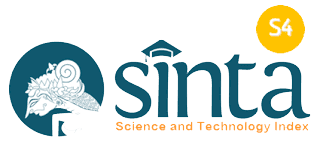The Effect of Apparatus Resource Development on Performance Improvement at the Regional Secretariat of Gowa Regency
(1) Faculty of Administrative Science, Universitas Pepabri Makassar, Indonesia
(2) Faculty of Administrative Science, Universitas Pepabri Makassar, Indonesia
(3) Faculty of Administrative Science, Universitas Pepabri Makassar, Indonesia
(*) Corresponding Author
DOI: https://doi.org/10.26858/pdr.v5i2.32741
Abstract
The purpose of this research paper is to determine the development of Apparatus Resources through education and training in the Gowa Regency Secretariat Office Scope viewed from the aspect of competence and motivation. The data sources in this study were obtained by giving questionnaires or questionnaires to respondents at the Gowa Regency Secretariat . The research design used in this study is a quantitative approach. The research used by the researcher is field research, namely by examining directly the object under study.The results obtained from the comparison of the value of sig. to the level of significance: sig. = 0.002 < 0.05. Because sig. < , the training variable partially (individually) has a significant effect on employee performance. the tcount value is 5.075 and the ttable value is known to be 2,000. By comparing between tcount and t - table, it is found that tcount > ttable = 5.075 > 2,000, because the value of t - count is greater than t - table, it can be concluded that the regression coefficient of the motivation variable is significant. And the results obtained from the comparison of the value of sig. with the level of significance: sig. = 0.000 < 0.05. Because sig. < , it can be concluded that H2 is accepted and H0 is rejected, meaning that the regression coefficient on the Motivation variable partially (individually) has a significant effect on Employee Performance s. The coefficient obtained by the tcount is 2.365 and the ttable value is known to be 2,000. By comparing between t - count and t - table , it is found that t-count > t - table = 2.365 > 2,000, because the value of t-count is greater than t - table.
Keywords
Full Text:
PDFReferences
Bhatnagar, D., Currier, A., Hernandez, J., Ma, O., & Kirby, B. (2013). Market and policy barriers to energy storage deployment. Sandia National Lab.(SNL-NM), Albuquerque, NM (United States).
Chakraborty, A. (2011). Advancements in power electronics and drives in interface with growing renewable energy resources. Renewable and Sustainable Energy Reviews, 15(4), 1816–1827.
Darmi, T., & Suwitri, S. (2017). Strengthening the capacity of human resources apparatus in the implementation of new autonomous regions. European Journal of Social Sciences, 55(4), 427–438.
Delis, H., Christaki, K., Healy, B., Loreti, G., Poli, G. L., Toroi, P., & Meghzifene, A. (2017). Moving beyond quality control in diagnostic radiology and the role of the clinically qualified medical physicist. Physica Medica, 41, 104–108.
Ekayanti, S. M., Rifa, A., & Irwan, M. (2018). Determinants effectiveness fixed asset management of district government on the Island of Lombok. International Journal of Business Management and Economics Research (IJBMER), 9(1), 1219–1229.
Farida, I., Setiawan, R., Maryatmi, A. S., & Juwita, M. N. (2020). The Implementation of E-Government in The Industrial Revolution Era 4.0 in Indonesia. International Journal of Progressive Sciences and Technologies, 22(2), 340–346.
Hardiyansyah, H., Koesharijadi, K., & Akbar, M. (2020). E-Government Policy, Leadership Commitment, Apparatus Resources Development, and Their Implications on Public Service Performance. 3rd Forum in Research, Science, and Technology (FIRST 2019), 74–78.
Jasi, D. S., & Bura, R. O. (2019). Strategic Capability Development of Human Resources to Achieve Self-Reliant of Indonesia Defense Industry. 2019 International Conference on Computational Intelligence and Knowledge Economy (ICCIKE), 742–745.
Joseph, T., Ugalde-Loo, C. E., Liang, J., & Coventry, P. F. (2018). Asset management strategies for power electronic converters in transmission networks: Application to HVDC and FACTS devices. IEEE Access, 6, 21084–21102.
Mahmud, R., Kotagiri, R., & Buyya, R. (2018). Fog computing: A taxonomy, survey and future directions. In Internet of everything (pp. 103–130). Springer.
Malik, A. (2019). Creating competitive advantage through source basic capital strategic humanity in the industrial age 4.0. International Research Journal of Advanced Engineering and Science, 4(1), 209–215.
Mustainah, M., Samad, M. A., & Kusuma, E. Z. (2020). Apparatus Resources Development in The Regional Agency of the Palu City. International Journal of Multicultural and Multireligious Understanding, 7(7), 233–237.
Othman, M., Madani, S. A., & Khan, S. U. (2013). A survey of mobile cloud computing application models. IEEE Communications Surveys & Tutorials, 16(1), 393–413.
Paranoan, D. B. (2013). Apparatus Resources Development Model to Improve Public Service Quality in Indonesia. Journal of Information Engineering and Applications, 3(3), 38–45.
Shlobin, N. A., & Rosenow, J. M. (2022). Ethical considerations in the implantation of neuromodulatory devices. Neuromodulation: Technology at the Neural Interface, 25(2), 222–231.
Wibowo, E. B., Legionosuko, T., Mahroza, J., & Chandra Jaya, Y. (2020). Industry 4.0: Challenges and Opportunities in Competency Development for Defense Apparatus’ Human Resources. Int. J. Adv. Sci. Technol, 29, 45–60.
Zainal, H., Rakib, M., Ashar, A. I., Manda, D., Sose, A. T., & Setitit, I. (2020). Strategy of human resources development in improving performance Apparatus in the Bone Regency Regional Inspectorate. Pinisi Business Administration Review, 2(1), 35–44.
Article Metrics
Abstract view : 171 times | PDF view : 24 timesRefbacks
- There are currently no refbacks.
Copyright (c) 2022 Andi Pattarani, Andi Rahmatia, Nur ilmiah Rivai


































